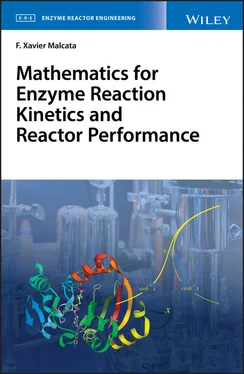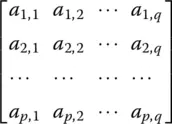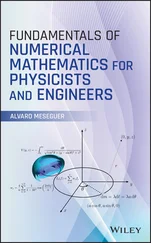F. Xavier Malcata - Mathematics for Enzyme Reaction Kinetics and Reactor Performance
Здесь есть возможность читать онлайн «F. Xavier Malcata - Mathematics for Enzyme Reaction Kinetics and Reactor Performance» — ознакомительный отрывок электронной книги совершенно бесплатно, а после прочтения отрывка купить полную версию. В некоторых случаях можно слушать аудио, скачать через торрент в формате fb2 и присутствует краткое содержание. Жанр: unrecognised, на английском языке. Описание произведения, (предисловие) а так же отзывы посетителей доступны на портале библиотеки ЛибКат.
- Название:Mathematics for Enzyme Reaction Kinetics and Reactor Performance
- Автор:
- Жанр:
- Год:неизвестен
- ISBN:нет данных
- Рейтинг книги:3 / 5. Голосов: 1
-
Избранное:Добавить в избранное
- Отзывы:
-
Ваша оценка:
Mathematics for Enzyme Reaction Kinetics and Reactor Performance: краткое содержание, описание и аннотация
Предлагаем к чтению аннотацию, описание, краткое содержание или предисловие (зависит от того, что написал сам автор книги «Mathematics for Enzyme Reaction Kinetics and Reactor Performance»). Если вы не нашли необходимую информацию о книге — напишите в комментариях, мы постараемся отыскать её.
Enzyme Reactor Engineering
The second volume begins with an introduction to basic concepts in calculus, i.e. limits, derivatives, integrals and differential equations; limits, along with continuity, are further expanded afterwards, covering uni- and multivariate cases, as well as classical theorems. After recovering the concept of differential and applying it to generate (regular and partial) derivatives, the most important rules of differentiation of functions, in explicit, implicit and parametric form, are retrieved – together with the nuclear theorems supporting simpler manipulation thereof. The book then tackles strategies to optimize uni- and multivariate functions, before addressing integrals in both indefinite and definite forms. Next, the book touches on the methods of solution of differential equations for practical applications, followed by analytical geometry and vector calculus. Brief coverage of statistics–including continuous probability functions, statistical descriptors and statistical hypothesis testing, brings the second volume to a close.

 , the imaginary unit. Therefore, z is represented by a point in a plane domain. In the complex number system, a general n th degree polynomial equation holds exactly (and always) n roots, not necessarily distinct though – as originally realized by Italian mathematicians Niccolò F. Tartaglia and Gerolamo Cardano in the sixteenth century; many concepts relevant for engineering purposes, originally conceived to utilize real numbers (as the only ones adhering to physical evidence), may be easily generalized via complex numbers.
, the imaginary unit. Therefore, z is represented by a point in a plane domain. In the complex number system, a general n th degree polynomial equation holds exactly (and always) n roots, not necessarily distinct though – as originally realized by Italian mathematicians Niccolò F. Tartaglia and Gerolamo Cardano in the sixteenth century; many concepts relevant for engineering purposes, originally conceived to utilize real numbers (as the only ones adhering to physical evidence), may be easily generalized via complex numbers. , as per Pythagoras’ theorem), coupled with orientations (as per tan{ b / a } and tan{ c /
, as per Pythagoras’ theorem), coupled with orientations (as per tan{ b / a } and tan{ c /  }) fully define the said triplet. An alternative representation is as [ a b c ] or
}) fully define the said triplet. An alternative representation is as [ a b c ] or  – also termed row vector or column vector, respectively; when three column vectors are assembled together, say,
– also termed row vector or column vector, respectively; when three column vectors are assembled together, say,  ,
,  , and
, and  , a matrix results, viz.
, a matrix results, viz.  , termed tensor – which may also be obtained by joining three row vectors, say, [ a 1 a 2 a 3], [ b 1 b 2 b 3], and [ c 1 c 2 c 3]. The concept of matrix may be generalized so as to encompass other possibilities of combination of numbers besides a (3 × 3) layout; in fact, a rectangular ( p × q ) matrix of the form
, termed tensor – which may also be obtained by joining three row vectors, say, [ a 1 a 2 a 3], [ b 1 b 2 b 3], and [ c 1 c 2 c 3]. The concept of matrix may be generalized so as to encompass other possibilities of combination of numbers besides a (3 × 3) layout; in fact, a rectangular ( p × q ) matrix of the form  , or [ a i,j; i = 1, 2 ,…, p ; j = 1, 2 , …, q ] for short, may easily be devised.
, or [ a i,j; i = 1, 2 ,…, p ; j = 1, 2 , …, q ] for short, may easily be devised. may be also represented as
may be also represented as  , provided that, say, A 1,1≡ [ a 1], A 1,2≡ [ a 2 a 3],
, provided that, say, A 1,1≡ [ a 1], A 1,2≡ [ a 2 a 3],  , and
, and  represent, in turn, smaller matrices. An issue of compatibility arises in terms of the sizes of said blocks, though; for a starting ( p × q ) matrix A, only ( p 1× q 1) A 1,1, ( p 1× q 2) A 1,2, ( p 2× q 1) A 2,1, and ( p 2× q 2) A 2,2matrices are allowed – obviously with p 1 + p 2 = p and q 1 + q 2 = q .
represent, in turn, smaller matrices. An issue of compatibility arises in terms of the sizes of said blocks, though; for a starting ( p × q ) matrix A, only ( p 1× q 1) A 1,1, ( p 1× q 2) A 1,2, ( p 2× q 1) A 2,1, and ( p 2× q 2) A 2,2matrices are allowed – obviously with p 1 + p 2 = p and q 1 + q 2 = q .











